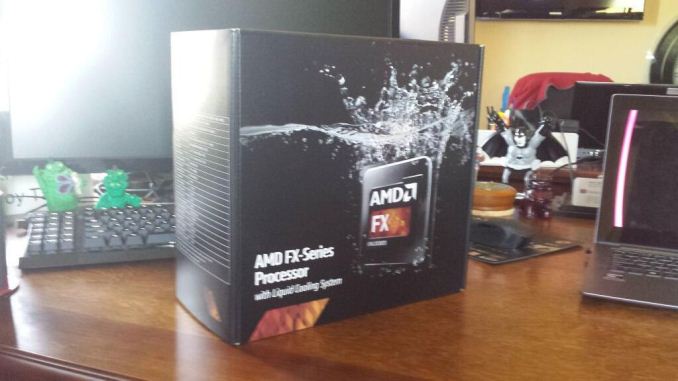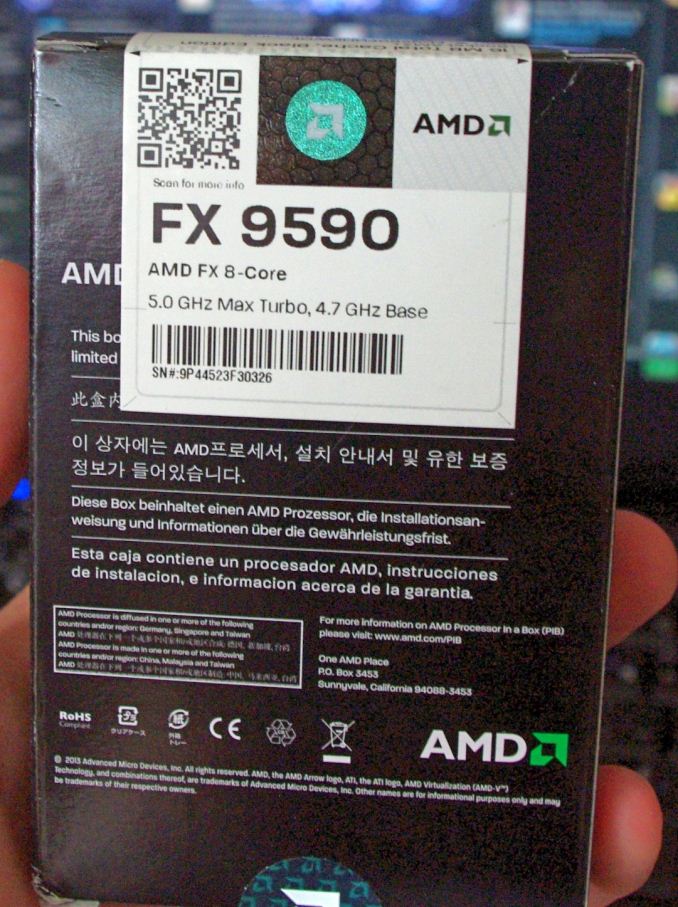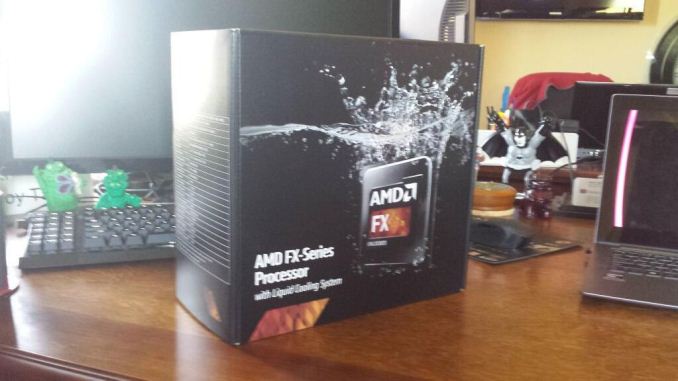AMD’s 5 GHz Turbo CPU in Retail: The FX-9590 and ASRock 990FX Extreme9 Review
by Ian Cutress on August 9, 2014 8:00 AM EST
While AMD’s FX-9590 CPU has been in systems for over a year, it suddenly comes to market as a retail package for end-users to buy with a bundled liquid cooling system. This 220W CPU that has a turbo speed of 5.0 GHz still sits at the top of AMD’s performance stack, despite subsequent improvements in the architecture since. We have decided to grab ASRock’s 990FX Extreme9 and an FX-9590 for a review to see if it still is the AMD performance CPU champion.
Spot the CPU
The story behind AMD’s fastest ever x86 CPUs is slightly odd. Two models, the FX-9590 and FX-9370, were both launched into OEM channels in June 2013. Being an OEM component, the only way to get one was in a pre-built system through a retailer, or through a bulk system integrator that had a model around one of these CPUs. Typically this is a process that is only exhibited with server class processors: from a range of CPUs being produced, only several will be available for end-users at retail because server CPUs usually go through a system builder. At the time, it seemed that AMD concerned that the high TDP of this CPU, at 220W listed, is too much for most cooling setups within a home user system and the best way to get it to consumers would be if a system builder chose the appropriate cooling for them.
As a result of this orientation of sales, AMD did not sample the media with review units. We review an AMD product typically though an AMD sourced sample. It was also noted that the OEM price for the CPU was near $900 for the FX-9590, which seemed like an excruciating amount for what was essentially a good overclocking version of the FX-8350. Several media websites were able to collaborate with system builders in order to get a chance to review the CPU, and AMD was confident in their promotion and handling of the new CPU.
Anecdotally, in my field of vision, the promotion of this CPU was relatively limited. The price was the main factor, resulting in comparative AMD/Intel systems being more power hungry on the AMD side, and substantially more expensive when put up against the latest mainstream i7 at the time. As a result, while some retailers were selling the OEM CPU at full price, some retailers decided to sell their OEM stock with a severe price cut directly to consumers, down from $900 to $390, in order to get rid of units (this is when I picked up our sample).
Due to the OEM nature of these sales to end-users, each CPU had either no warranty with AMD or a limited warranty. For the user interested in a 3-year system cycle without the fear of a bad egg, the OEM route is never a positive one.
AMD subsequently released, relatively silently, a proper package and retail version of the FX processors. It was apparent that this was in response to the OEM sales, with the retailers list ‘heatsink and fan not included’ alongside the specifications.
| AMD FX CPU Comparison | ||||||
|
FX- 4350 |
FX- 6350 |
FX- 8320 |
FX- 8350 |
FX- 9370 |
FX- 9590 |
|
| Release Date |
April 2013 |
October 2012 | October 2012 | October 2012 | June 2013 | June 2013 |
| Modules | 2 | 3 | 4 | |||
| L1 Cache (Code) | 128 KB | 192 KB | 256 KB | |||
| L1 Cache (Data) | 64 KB | 96 KB | 128 KB | |||
| L2 Cache | 4 MB | 6 MB | 8 MB | |||
| L3 Cache | 8 MB | |||||
| TDP | 125W | 220 W | ||||
| Base Frequency | 4200 | 3900 | 3500 | 4000 | 4400 | 4700 |
| Turbo Frequency | 4300 | 4200 | 4000 | 4200 | 4700 | 5000 |
| Core Name | Vishera | |||||
| Microarchitecture | Piledriver | |||||
| Socket | AM3+ | |||||
| Memory Support | DDR3-1866 | |||||
| Price (US) | $140 | $140 | $160 | $190 |
$230 $300 CLC |
$300 $370 CLC |
Since that release, AMD has not upgraded their enthusiast processor line with the latest architecture. The FX line has stayed where it is, perhaps for a number of reasons. One could speculate that releasing the next generation of FX-85xx might put them behind the FX-9590 in performance, or that the fabrication process was not suitable for a quad-module CPU with the new architecture improvements. The FX line for desktops, as far as we know, is staying at 32nm with no improvements.
Now Available
Fast forward twelve months to June 20th 2014 and Roy Taylor, AMD’s VP of Global Channel Sales tweets this innocuous picture:
Speculation was rife as to what this was. Here is a large box for an FX processor with the words ‘with Liquid Cooling System’ underneath. AMD supplied liquid cooling to the media when we reviewed the FX-8350 CPUs, the main CPU that sits underneath the FX-9590 and FX-9370, so there was an expectation that was something new.
On June 26th, the @AMDFX twitter account posted the following, confirming that this was the older FX-9590 but in a retail box with retail cooling:
To celebrate the start of ‘Round of 16’, we’re giving away eleven FX-9590 CPUs! #FXCUP pic.twitter.com/21JRaHdMq8 — AMD FX (@AMDFX) June 26, 2014
The AMD FX Processor page has been updated accordingly, showing the same render of the new box. Here we see that the liquid cooler is supplied by Cooler Master, and uses a wide range PWM fan as part of the package.
Of course, this leaves several questions unanswered: how much, when is it on sale, where is it on sale, and is it still any good? Well for the US at least, it is on sale today from Newegg at $370 with the water cooling kit, or $330 without. NCIX has it listed for CAD$500, although this is currently in ‘back stock’ mode.
The SKU to look for is the FD9590FHHKWOX, which in the UK does not seem to be on the shelves as of yet. Amusingly, when this is typed in to Google, the search engine asked me if I meant FD9590FHHKWOF, the non-CLC version.
This Review
Back when the FX-9590 was originally released alongside the FX-9370, we were unable to secure a sample from AMD and the limited availability made us feel the CPU had a fairly limited scope for testing. However, now the landscape has changed. There has been no new FX CPUs on the market from AMD, and this subsequent release of a retail version piques the interest as to how relevant AMD still sees their high-frequency part. Because I now have a FX-9590 all of my own to test from when the OEM stock was sold, I felt it was worth revisiting to see if it can be considered an investment.
Alongside testing this CPU, the 220W TDP requires a substantial motherboard to match. Due to the age of the platform, the AM3+ socket and the old 990FX chipset, finding a motherboard can be rather tricky. Many of the AM3+ motherboards that were launched were only suited for the FX-8350 processors, which had a 125W TDP. This is yet another reason that AMD wanted the FX-9590 in the hands of system builders who would chose high end motherboards that could cope.
Two of the newest motherboards to be released for 990FX were the ASRock 990FX Killer and the ASRock 990FX Extreme9. We reported the release of the Killer in December 2013, but the Killer is unsuitable here as the specification sheet lists processors up to 125W only. The Extreme9 is ASRock’s high-end AM3+ motherboard, and more suited to the task. Luckily I had requested a sample almost a year ago for some regression testing, so we will be reviewing this motherboard as part of this article.














146 Comments
View All Comments
just4U - Monday, August 11, 2014 - link
I think coolermaster makes it.. Not bad, not great.. You'd be better served getting the the variant without liquid cooling (I think..) and than deciding on your own what you need.Natfly - Tuesday, August 12, 2014 - link
Garbage....you can't polish a turd.The_Riddick - Wednesday, August 13, 2014 - link
These processors really need to be running at below Intel wattage in order to be competitive, even if they tried and sold me one of these cpus for $10 I wouldn't buy one. 220W and performs worse then i5, no thanks.TiGr1982 - Wednesday, August 13, 2014 - link
Well, this same FX Piledriver certainly can run below Intel wattage (say, around 70 W for the CPU itself), but only at no more than 2.5-3.0 GHz frequency - like Opterons 6300 do.Then, it won't make a lot of sense on the desktop either :)
eanazag - Friday, August 15, 2014 - link
AMD misunderstood me.Before this product was initially released as an OEM part I had posted on an AMD article that I would be interested in a 200 W APU not CPU. I wouldn't mind an APU that could clock the GPU and CPU outrageously. I have a 300 W video card plus a 105 W Intel CPU, which the CPU is supposed to be 95 W. So a 200 W APU that comes close to both of those is a cost savings if it will clock down while idle. Plus space and heat savings.
Evidently they opted for doing it with this CPU. This is not totally bad, but between the pricing, performance, chipset features, and efficiency versus the 8350 and Intel parts it is really tough to justify. I saw numbers in there for workloads where the Haswell i3 is more than the 9590. I bought the Phenom 9600 with the errata and the CPU was fine, but I am still not willing to go that far in loyalty to AMD on the CPU side anymore. They would do better to just import the 8350/9590 silicon onto their 28 nm process. So what if it takes a clock regression as it will also have a TDP drop. They really need to do a better job updating their chipsets. This is less forgivable than their CPU line. That old, crappy 9590 would look better with a new chipset (PCIe 3 at least).
0ldman79 - Monday, August 18, 2014 - link
I've been running AMD in my desktops as a primary since the K6-2 (and K6-3+ mobile in a desktop if anyone remembers that gem).That being said, I have to call the current generation as AMD's version of the Pentium 4. I have an FX6300 in my main gaming PC. While it does well, it just isn't up to par with Intel's offerings.
I've been keeping an eye out for the next version of the AM3+ performance line and found that I've pretty much got it.
Uh... what?
AMD's flagship performance socket, AM3, has pretty much been dropped completely with all focus towards hot dual cores (seriously, that is what they are) with some rather nice integrated graphics. While I've sold several of these to my business customers I'm seriously considering jumping to Intel for my rigs.
The biggest reason is I've always had an upgrade path with AMD. It was always easy to keep building a new AMD as I'd have a couple of generations of CPU available to a platform and some of my parts from the previous system would cross. It was rarely ever a 100% replacement, more a long term evolution.
My next system will likely require a new motherboard to replace what is to me a fairly new board. With AMD effectively dropping the AM3 line just after I got onboard, I've got a sour taste in my mouth.
Those Core i7 are looking better. AMD has done this to themselves.
They took their IT customers, those that tell everyone else what to buy, told them about this awesome new CPU on the AM3 platform, the ultimate of the Bulldozer line, walked them out blindfolded for the big reveal, then walked away. We're standing there in a field of nothing with a blindfold on looking like jackasses.
That is what I think of AMD's current roadmap.
Cryio - Tuesday, August 19, 2014 - link
The absolutely BEST game for CPU benchmarking remains Crysis 3.I don't know why they use Tomb Raider and Company of Heroes which both are CPU agnostic. Not to mention that F1 series just hates AMD CPUs for whatever reason.
Games that really use the CPU: Crysis 3, Hitman Absolution, Assassin's Creed IV (I think). GRID 2, or really any mainline DIRT games. Hell, even Watch Dogs.
If any of those games that know how to properly use more than 2-4 cores were tested then this AMD beast would wipe the floor with those i3s.
Budburnicus - Wednesday, January 14, 2015 - link
LMAO!Just laughing at "This AMD "beast" would wipe the floor with those i3s." - You used beast to describe AMD's flagship product, and then talked about proper software coding allowing it to wipe the floor - wiiith i3s! LOL! just LOL!
I really am not sure if you were being sarcastic or actually meant that, but I hope it was sarcasm!
nctritech - Monday, October 20, 2014 - link
I just got an FX-9590 and an ASUS M5A99FX PRO R2.0 motherboard to go with it. I closely examined available Intel options and chose this chip. Most of the comments here put down this chip and AMD because Intel has higher-performing options and most of those comments are completely missing one vital factor: PRICE. I got this combo for $355 tax + shipping. Even if you go with the previous generation of Intel's flagship CPU, the i7-3770K, Newegg has them TODAY for $330. Hmm, that's almost as much as I paid for the FX with a brand new motherboard! Same story for the i7-4770K at $335.I walked away during a CPU sale special paying $220 total for the FX-9590 chip. It's faster in video compression benchmarks than EVERY desktop Intel chip EXCEPT the X-series i7 chips. It runs with or near the 3770K and 4770K in almost every other benchmark, possibly excluding games.
For those of you jeering at "efficiency" and praising how much faster Intel's Haswell chips can be, I wish you the best...but I'll be able to get an SSD, better RAM, or a nicer graphics card because I have $100 extra in my pocket, all while enjoying roughly the same performance as the Intel chips you've formed a cult around. Best of all, there's no LGA socket with extremely fragile pins to void my warranty; you know, when you return a mobo and they refuse to honor your return because "user-caused CPU socket pin damage" even though it was sent back because a nearby defective power component visibly burned up. Plus, did you know that CPUs only use their TDP worth of heat when you're taxing them to the maximum constantly? Who knew?!
You can have your lower performance-per-currency-unit chips and theoretical efficiency, I'll take the best overall deal, thanks!
Jinx50 - Sunday, November 2, 2014 - link
I agree enthusiast's are rarely concerned with power consumption. I quote a user i encountered who stated My Haswell is more energy efficient "meanwhile they have their rig picture with 3 Titans running in 3 way SLI for their avatar". Pure derp and a grasping desperately for the one and only straw they have in regards to downplaying the FX lineup. It's obviously neither price or performance, or multitasking for that matter.I've just become accustomed to tuning them out like annoying kids at the pub.